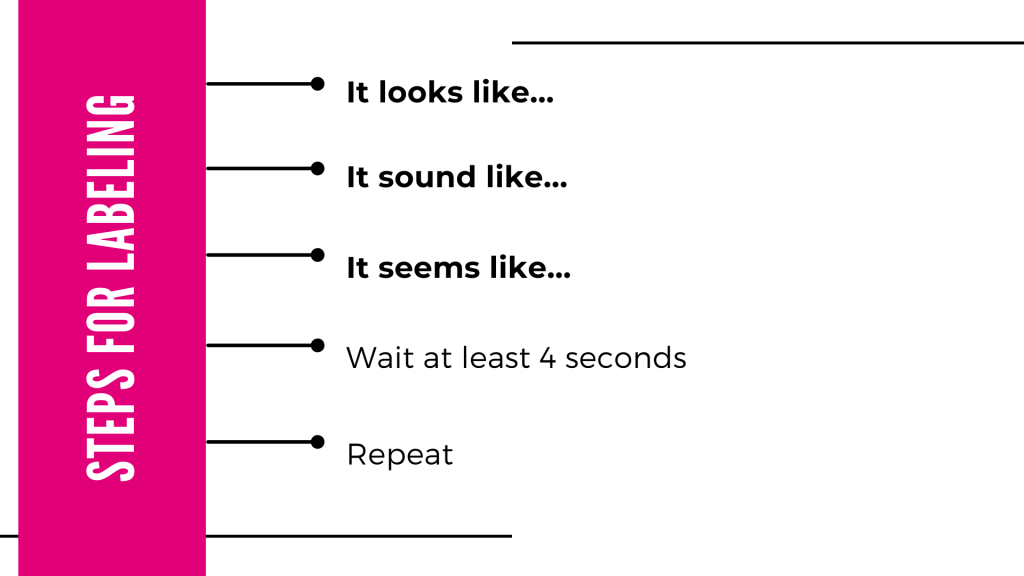PART 3: Labeling
In the previous blog we talked about using mirroring in a negotiation, and now we can move on to labeling.
Labeling is a way of validating someone’s emotion by acknowledging it. Why is that so important? Shouldn’t we focus on our side of the negotiation? No.
Remember in our first blog: How to say it, where we talked about the importance of active listening and how it is crucial for any successful negotiation. Because when we listen to what the other person has to say, they feel respected and understood and most importantly, they get less defensive, therefore the conflict can resolve. If the person feels like you don’t understand them, they won’t cooperate. All the negotiation skills in the world won’t help you if you don’t listen and label their emotions.
So, listen and observe, because you can acquire information from the other person’s words, tone and body language. And, once you spotted an emotion you want to highlight, you can label it.
How do you do that?
Always remember to label the underlying feelings that motivate the behavior. Do not focus on how the person is acting but why.
Labels can be statements or questions and they can end in a downward or upward inflection, but they must start with the following words:
- It seems like…
- It sounds like…
- It looks like…
Never use the word I, because it shows you are more interested in yourself than the other person, negating everything we mentioned before. If it’s a neutral statement it encourages the counterpart to be more responsive. If they disagree with the label, you can always back up and say: I didn’t say that was what it was. I just said it looks like it.
The last step is silence. Give the counterpart a chance to reveal himself.

Here’s an example:
Let’s say you are trying to sell expensive kitchenware to an older audience in a shopping centre. You put up a stand and wait for potential customers to walk by and get interested in your product. An older woman comes up to the stand and starts looking at a specific cooking pot. She has it in her hands and is looking at every detail and asking you about all its characteristics, like what are its measurements, the material, how much temperature can it handle and so on. After careful listening you can imagine she’s a home cook who takes cooking appliances very seriously.
Now remember, you now know how she’s acting, but to negotiate into selling the cooking pot to her, you need to know why she’s acting like this. You need to find the underlying feeling that motivate her behavior. So, label!
As she’s looking at every detail, you can say: “It looks like the design of the pot is very important to you?”
If it’s true she will say something like: “Yes, I like that all of my kitchen appliances compliment each other so my kitchen looks great.”
Now you know that she is buying the design, because she likes things to match and that they compliment her kitchen, not only because she likes the way it looks on its own.
You have gathered new information and you can label even deeper: “It seems like you like to keep your kitchen beautiful for your family or guests.”
Again, she might agree: “Yes of course, I love cooking for my family. Spending time with my grandchildren in my kitchen is my favorite thing to do.”
Yes! You’ve got it. The underlying feeling. It’s not about cooking at all. It is about spending time with her family and cooking only the best for them. Now you know that everything you say, or try to sell, has to compliment her feelings of love, family, good food and spending time together: “It sounds like you love your family and try your very best to cook delicious food for them and also spending time together.” To that she would definitely say: “That’s right!”
With that you can start selling your product so, that it represents her deepest desires. You can say, that because it’s a big pot, you can cook a big meal in it for a family of 6, or that it has a safety lid, so that it is safer for her grandchildren who are in the kitchen with her and so on. Now she is not buying a cooking pot but buying another way to spend time with her family.
And like we mentioned before, don’t worry if your counterpart doesn’t agree with a label. Just say: “I didn’t say that was what it was. I just said it looks like it.”, move on to the next one and label away.





